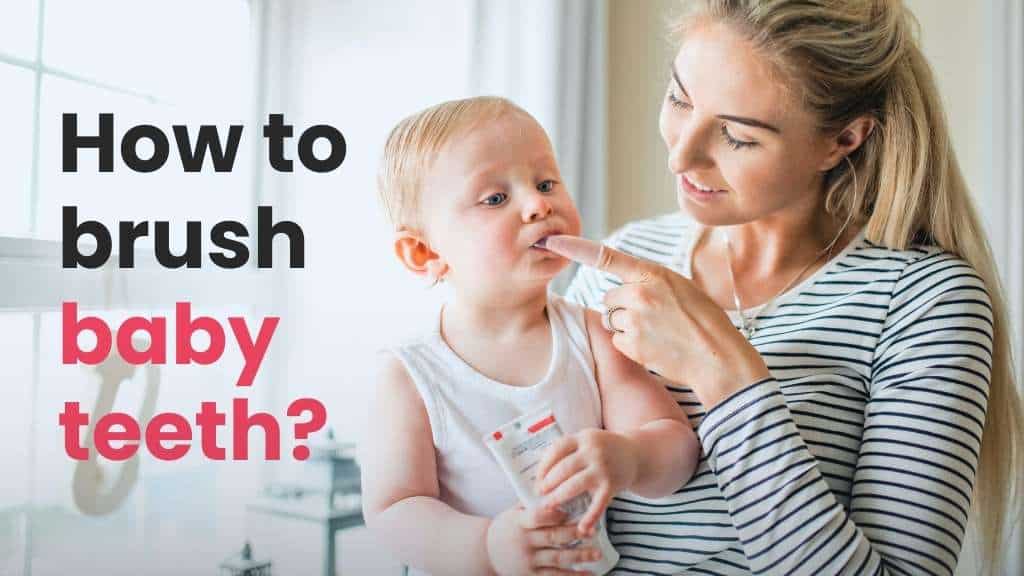
Table of Contents
Introduction :
As a parent, you understand the importance of nurturing your little one’s health from the earliest stages. Among the many care routines, ensuring your baby’s dental hygiene stands as a vital pillar. While the idea of introducing a toothbrush into your baby’s routine might seem daunting, fear not – we’re here to provide you with insights, strategies, and tips that will make this journey not only manageable but also enjoyable.
In this guide, we will shed light on how to brush a babys teeth and give you tips so that you can brush your little one’s teeth without any worry.
Should I Clean My Baby's Gums?
Absolutely! Introducing gum cleaning for your little one is a wonderful step. Even before their first tooth emerges, their mouth can host bacteria due to sugars in breast milk or formula. These sugars, if left on the gums, encourage bacterial growth. While some bacteria are normal, it’s crucial to limit excess growth to prevent future dental concerns. Additionally, avoiding bedtime bottle habits is essential, as liquids during sleep can prolong exposure, leading to increased bacteria and potential issues down the road.
Baby Oral Care: Building Healthy Habits
Setting the stage for excellent oral hygiene for your little one begins with establishing a baby dental care routine right from the start. Beyond fostering good hygiene practices for the future, this routine offers a wonderful opportunity for parent-child interaction. Cleaning your baby’s mouth can become a special bonding time, filled with cuddles and closeness. The objectives of this routine should be to:
- Establish a pattern of brushing at least twice daily.
- Maintain your baby’s mouth cleanliness.
- Familiarize your baby with the sensation of a clean mouth.
These goals are straightforward, yet many parents are unsure when to initiate brushing for their baby’s teeth and gums, as well as how to introduce tooth brushing to a baby.
0-6 Months
At birth, babies lack teeth, so using a toothbrush and toothpaste isn’t needed. Yet, brushing their gums gently fosters a habit of oral care. After feeding, use a clean, damp washcloth or baby gum brush on their gums. Do this at least twice daily to mimic a brushing routine. For newborns, terrycloth finger cots are another option found in drugstores. Around six months, babies get their first tooth. Despite teething discomfort, maintaining oral care is essential: it prepares for emerging teeth and eases discomfort through gentle massage.
A crucial reminder: Dental decay stems from mouth-dwelling bacteria, which can be transferred to your child. To prevent this, avoid sharing cups or utensils, don’t clean their pacifier with your mouth, and never use your mouth to test their bottle’s temperature.
6-12 Months
At this pivotal developmental stage, most children experience teething, leading to more drooling and a tendency to chew on objects. With the emergence of teeth, it’s time to consider their first dental visit. Tooth decay doesn’t discriminate by age, so the American Dental Association recommends the first dental appointment within six months of the first tooth or by the first birthday, whichever comes first.
During this phase, transitioning from a bottle to a cup is crucial. While bottles aren’t inherently problematic, allowing babies to sip throughout the day exposes their mouths to sugars in formula, breast milk, and juice, raising the risk of tooth decay.
As your baby can hold a cup, introduce the shift to a sippy cup, but avoid unrestricted use. Create a structured routine for drinks and snacks to prevent prolonged cup-holding. Discourage falling asleep with a bottle or cup, and explore alternative soothing methods for sleep.
When to Begin Baby Tooth Care?
Before your baby’s first tooth emerges, continue using the gum-cleaning technique mentioned earlier, as a toothbrush might not be comfortable on their gums. Once that first tooth appears, transition to a soft-bristled infant brush. However, remember to keep cleaning the gums! Even with a tooth, their gums are still exposed to whatever they put in their mouth. Regular gum cleaning is vital until more teeth emerge to cover the gum area and provide relief as new teeth break through.
When that first tooth arrives, it’s time to plan their initial dental visit. This visit isn’t about using electric toothbrushes on tiny teeth but establishing good oral care habits, assessing their oral health, and creating a foundation for the future. Opting for a pediatric dentist shows your commitment to their oral health. These specialists focus on children, providing invaluable knowledge and support for their long-term well-being, including comfort with dental care and the basics of oral hygiene.
How to Brush a Babys Teeth?
Brushing your baby’s teeth may seem straightforward, but it can sometimes turn into a challenging task for parents. Babies can wiggle, fuss, or doze off unexpectedly. They might resist having foreign objects in their mouth or attempt to grasp the toothbrush. So, how can parents navigate this situation?
First and foremost, stay calm. While your baby’s oral care is important, it shouldn’t cause undue stress. Your presence here, reading about cleaning your baby’s teeth, reflects your concern and care.
Now that you’re feeling at ease, let’s address some common queries about maintaining your baby’s dental hygiene.
When to Introduce Toothpaste for Babies?
Before your baby’s first tooth emerges, gently wipe their gums with a clean, damp washcloth. No toothpaste or additional products are necessary at this stage. Once your baby starts getting teeth, switch to a soft-bristled toothbrush. Initially, water is sufficient, but as more teeth appear, you can introduce a tiny smear of toothpaste designed for babies’ brushing routine.
Some children’s toothpaste doesn’t contain fluoride, a mineral that aids in preventing tooth decay. Previously, dentists recommended fluoride-free toothpaste for children under 2 years old. However, the American Academy of Pediatrics has updated these recommendations, permitting fluoride toothpaste at all ages, with cautious and direct parental oversight. Using a “smear” (amount of a grain of rice) of fluoride toothpaste is safe and advised as soon as your baby has teeth.
What Toothbrush Is Suitable for My Child?
The transition from a washcloth to a soft-bristled toothbrush varies among parents. Some opt for silicone finger brushes, which can help ease the transition to brushing baby teeth. These brushes have nubs that clean teeth and offer a comforting sensation for the baby’s gums. As your child progresses, there’s a variety of baby toothbrushes available. These brushes come with age-appropriate labels, making your choice easier. Brushes designed for babies and young toddlers typically have wider handles for easy gripping and are available in vibrant colors and character designs to encourage brushing. While silicone brushes are gentle on gums, nylon bristle brushes are more effective at removing plaque from teeth.
How to Brush a Babys Teeth?
The simplest approach to brushing your baby’s teeth is to lay them down on a floor, bed, changing table, or crib. Support their head for better access. This lets you use one hand to move their lips and cheeks aside while brushing with the other. Ensure you clean the visible front surfaces as well as the less visible back surfaces and grooves. Just like adults, babies can develop gingivitis, so brush along the gum line to prevent bleeding gums and gum disease. Since babies can be squirmy, consider having two adults—one to hold the baby and the other to focus solely on brushing.
Now that you know how to brush a babys teeth, let’s address some other issues you might face.
Handling Resistance to Brushing?
As your baby grows into a toddler, getting them to stay put for tooth brushing becomes a challenge. However, maintaining oral hygiene is vital. To engage your child during brushing:
- Let them choose their toothbrush or opt for one featuring their favorite character.
- Make it enjoyable with a fun song, dance, or character video during brushing.
- Stay calm and avoid frustration, as tension can make brushing a negative experience.
Final Thoughts on How to Brush a Babys Teeth
You shape your child’s approach to oral hygiene. Prioritizing it teaches them to do the same. Incorporating brushing into their routine is easy and prevents future difficulties. Partner with a pediatric dentist for your child’s oral health journey, just as you would with a pediatrician for overall health. Choose a pediatric dentist who can guide you from infancy, ensuring a solid dental routine. At Sprout Pediatric Dentistry & Orthodontics, we support families in Portland by sharing our expertise in fostering a healthy mouth from the very beginning.










